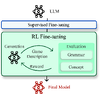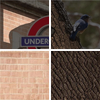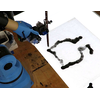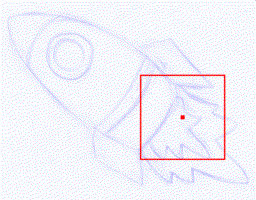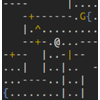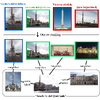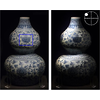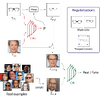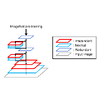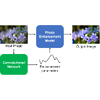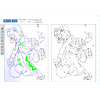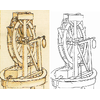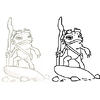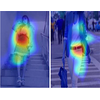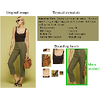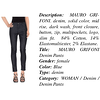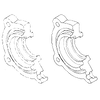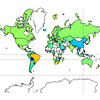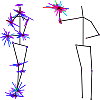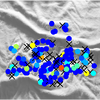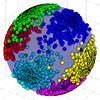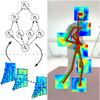2025
Game Description Generation (GDG) is the task of generating a game description
written in a Game Description Language (GDL) from natural language text. Previous
studies have explored generation methods leveraging the contextual understanding
capabilities of Large Language Models (LLMs); however, accurately reproducing the
game features of the game descriptions remains a challenge. In this paper, we
propose reinforcement learning-based fine-tuning of LLMs for GDG (RLGDG). Our
training method simultaneously improves grammatical correctness and fidelity to
game concepts by introducing both grammar rewards and concept rewards. Furthermore,
we adopt a two-stage training strategy where Reinforcement Learning (RL) is applied
following Supervised Fine-Tuning (SFT). Experimental results demonstrate that our
proposed method significantly outperforms baseline methods using SFT alone.
@InProceedings{TanakaCOG2025,
author = {Tsunehiko Tanaka and Edgar Simo-Serra},
title = {{Grammar and Gameplay-aligned RL for Game Description Generation with LLMs}},
booktitle = "Proceedings of the Conference on Games (CoG)",
year = 2025,
}
We propose a neural screen-space refraction baking method for global illumination
rendering, with applicability to real-time 3D games. Existing neural global
illumination rendering methods often struggle with refractive objects due to the
lack of texture information in G-Buffers. While some existing approaches extend
neural global illumination to refractive objects by predicting texture maps (UV
maps), they are limited to objects with simple geometry and UV maps. In contrast,
our method bakes refracted textures without these assumptions by directly encoding
the world coordinates of refracted objects into the neural network instead of UV
coordinates. Our experiments demonstrate that our approach performs better on
refraction rendering than previous methods. Additionally, we investigate the
differences in neural network performance when baking coordinates in different
spaces, such as world space, screen space, and UV space, showing the best results
yielded by baking in world-space coordinates.
@InProceedings{ZiyangCVPRW2023,
author = {Ziyang Zhang and Edgar Simo-Serra},
title = {{G-Buffer Supported Neural Screen-space Refraction Baking for Real-Time Global Illumination",
booktitle = "Proceedings of the Conference on Computer Vision and Pattern Recognition Workshops (CVPRW)",
year = 2025,
}
Traditional approaches in offline reinforcement learning aim to learn the optimal
policy that maximizes the cumulative reward, also known as return. It is
increasingly important to adjust the performance of AI agents to meet human
requirements, for example, in applications like video games and education tools.
Decision Transformer (DT) optimizes a policy that generates actions conditioned on
the target return through supervised learning and includes a mechanism to control
the agent's performance using the target return. However, the action generation is
hardly influenced by the target return because DT’s self-attention allocates scarce
attention scores to the return tokens. In this paper, we propose Return-Aligned
Decision Transformer (RADT), designed to more effectively align the actual return
with the target return. RADT leverages features extracted by paying attention
solely to the return, enabling action generation to consistently depend on the
target return. Extensive experiments show that RADT significantly reduces the
discrepancies between the actual return and the target return compared to DT-based
methods.
@Article{TanakaTMLR2024,
author = {Tsunehiko Tanaka and Kenshi Abe and Kaito Ariu and Tetsuro Morimura and Edgar Simo-Serra},
title = {{Return-Aligned Decision Transformer}},
journal = "Transactions on Machine Learning Research",
year = 2025,
volume = 1,
number = 1,
}
2024
Game Description Language (GDL) provides a standardized way to express diverse
games in a machine-readable format, enabling automated game simulation, and
evaluation. While previous research has explored game description generation using
search-based methods, generating GDL descriptions from natural language remains a
challenging task. This paper presents a novel framework that leverages Large
Language Models (LLMs) to generate grammatically accurate game descriptions from
natural language. Our approach consists of two stages: first, we gradually generate
a minimal grammar based on GDL specifications; second, we iteratively improve the
game description through grammar-guided generation. Our framework employs a
specialized parser that identifies valid subsequences and candidate symbols from
LLM responses, enabling gradual refinement of the output to ensure grammatical
correctness. Experimental results demonstrate that our iterative improvement
approach significantly outperforms baseline methods that directly use LLM outputs.
@Article{TanakaTOG2024,
author = {Tsunehiko Tanaka and Edgar Simo-Serra},
title = {{Grammar-based Game Description Generation using Large Language Models}},
journal = "Transactions on Games",
year = 2024,
volume = 1,
number = 1,
}
Neural rendering bakes global illumination and other computationally costly effects
into the weights of a neural network, allowing to efficiently synthesize
photorealistic images without relying on path tracing. In neural rendering
approaches, G-buffers obtained from rasterization through direct rendering provide
information regarding the scene such as position, normal, and textures to the
neural network, achieving accurate and stable rendering quality in real-time.
However, due to the use of G-buffers, existing methods struggle to accurately
render transparency and refraction effects, as G-buffers do not capture any ray
information from multiple light ray bounces. This limitation results in blurriness,
distortions, and loss of detail in rendered images that contain transparency and
refraction, and is particularly notable in scenes with refracted objects that have
high-frequency textures. In this work, we propose a neural network architecture to
encode critical rendering information, including texture coordinates from refracted
rays, and enable reconstruction of high-frequency textures in areas with
refraction. Our approach is able to achieves accurate refraction rendering in
challenging scenes with a diversity of overlapping transparent objects.
Experimental results demonstrate that our method can interactively render high
quality refraction effects with global illumination, unlike existing neural
rendering approaches.
@Article{ZiyangPG2024,
author = {Ziyang Zhang and Edgar Simo-Serra},
title = {{CrystalNet: Texture-Aware Neural Refraction Baking for Global Illumination}},
journal = {Computer Graphics Forum (Pacific Graphics)},
year = 2024,
}
Neural Global Illumination Baking with Neural Texture Mapping on
Refractive Objects
Ziyang Zhang, Edgar Simo-Serra
Visual Computing (ポスター), 2024
Hint-AUC: Deterministic Region-based Hint Generation for Line Art
Colorization Evaluation
Madono Koki, Yuan Mingcheng, Edgar Simo-Serra
Visual Computing (ポスター), 2024
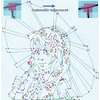
Deep Sketch Vectorization via Implicit Surface Extraction
Chuan Yan, Yong Li, Deepali Aneja, Matthew Fisher, Edgar Simo-Serra, Yotam
Gingold
ACM Transactions on Graphics (SIGGRAPH), 2024
We introduce an algorithm for sketch vectorization with state-of-the-art accuracy
and capable of handling complex sketches. We approach sketch vectorization as a
surface extraction task from an unsigned distance field, which is implemented using
a two-stage neural network and a dual contouring domain post processing algorithm.
This word is normally spelled with a hyphen. The first stage consists of extracting
unsigned distance fields from an input raster image. The second stage consists of
an improved neural dual contouring network more robust to noisy input and more
sensitive to line geometry. To address the issue of under-sampling inherent in
grid-based surface extraction approaches, we explicitly predict undersampling and
keypoint maps. These are used in our post-processing algorithm to resolve sharp
features and multi-way junctions. The keypoint and undersampling maps are naturally
controllable, which we demonstrate in an interactive topology refinement interface.
Our proposed approach produces far more accurate vectorizations on complex input
than previous approaches with efficient running time.
@Article{ChuanSIGGRAPH2024,
author = {Chuan Yan and Yong Li and Deepali Aneja and Matthew Fisher and Edgar Simo-Serra and Yotam Gingold},
title = {{Deep Sketch Vectorization via Implicit Surface Extraction}},
journal = "ACM Transactions on Graphics (SIGGRAPH)",
year = 2024,
volume = 43,
number = 4,
}
Object-Oriented Embeddings for Offline RL using Unsupervised Object
Detection
Tsunehiko Tanaka, Edgar Simo-Serra
画像の認識・理解シンポジウム(MIRU), 2024
Multimodal Markup Language Models for Graphic Design Completion
Kotaro Kikuchi, Naoto Inoue, Mayu Otani, Edgar Simo-Serra, Kota Yamaguchi
画像の認識・理解シンポジウム(MIRU), 2024
Neural rendering provides a fundamentally new way to render photorealistic images.
Similar to traditional light-baking methods, neural rendering utilizes neural
networks to bake representations of scenes, materials, and lights into latent
vectors learned from path-tracing ground truths. However, existing neural rendering
algorithms typically use G-buffers to provide position, normal, and texture
information of scenes, which are prone to occlusion by transparent surfaces,
leading to distortions and loss of detail in the rendered images. To address this
limitation, we propose a novel neural rendering pipeline that accurately renders
the scene behind transparent surfaces with global illumination and variable scenes.
Our method separates the G-buffers of opaque and transparent objects, retaining
G-buffer information behind transparent objects. Additionally, to render the
transparent objects with permutation invariance, we designed a new
permutation-invariant neural blending function. We integrate our algorithm into an
efficient custom renderer to achieve real-time performance. Our results show that
our method is capable of rendering photorealistic images with variable scenes and
viewpoints, accurately capturing complex transparent structures along with global
illumination. Our renderer can achieve real-time performance (256x256 at 63 FPS and
512x512 at 32 FPS) on scenes with multiple variable transparent objects.
@Article{ZiyangCVM2024,
author = {Ziyang Zhang and Edgar Simo-Serra},
title = {{Deep Sketch Vectorization via Implicit Surface Extraction}},
journal = "Computational Visual Media",
year = 2024,
volume = "??",
number = "??",
}
There exists a large number of old films that have not only artistic value but also
historical significance. However, due to the degradation of analogue medium over
time, old films often suffer from various deteriorations that make it difficult to
restore them with existing approaches. In this work, we proposed a novel framework
called Recursive Recurrent Transformer Network (RRTN) which is specifically
designed for restoring degraded old films. Our approach introduces several key
advancements, including a more accurate film noise mask estimation method, the
utilization of second-order grid propagation and flow-guided deformable alignment,
and the incorporation of a recursive structure to further improve the removal of
challenging film noise. Through qualitative and quantitative evaluations, our
approach demonstrates superior performance compared to existing approaches,
effectively improving the restoration for difficult film noises that cannot be
perfectly handled by existing approaches.
@InProceedings{LinWACV2024,
author = {Shan Lin and Edgar Simo-Serra},
title = {{Restoring Degraded Old Films with Recursive Recurrent Transformer Networks}},
booktitle = "Proceedings of the Winter Conference on Applications of Computer Vision (WACV)",
year = 2024,
}
2023
We present a novel framework for rectifying occlusions and distortions in degraded
texture samples from natural images. Traditional texture synthesis approaches focus
on generating textures from pristine samples, which necessitate meticulous
preparation by humans and are often unattainable in most natural images. These
challenges stem from the frequent occlusions and distortions of texture samples in
natural images due to obstructions and variations in object surface geometry. To
address these issues, we propose a framework that synthesizes holistic textures
from degraded samples in natural images, extending the applicability of
exemplar-based texture synthesis techniques. Our framework utilizes a conditional
Latent Diffusion Model (LDM) with a novel occlusion-aware latent transformer. This
latent transformer not only effectively encodes texture features from
partially-observed samples necessary for the generation process of the LDM, but
also explicitly captures long-range dependencies in samples with large occlusions.
To train our model, we introduce a method for generating synthetic data by applying
geometric transformations and free-form mask generation to clean textures.
Experimental results demonstrate that our framework significantly outperforms
existing methods both quantitatively and quantitatively. Furthermore, we conduct
comprehensive ablation studies to validate the different components of our proposed
framework. Results are corroborated by a perceptual user study which highlights the
efficiency of our proposed approach.
@Inproceedings{HaoSIGGRAPHASIA2023,
author = {Guoqing Hao and Satoshi Iizuka and Kensho Hara and Edgar Simo-Serra and Hirokatsu Kataoka and Kazuhiro Fukui},
title = {{Diffusion-based Holistic Texture Rectification and Synthesis}},
booktitle = "ACM SIGGRAPH Asia 2023 Conference Papers",
year = 2023,
}
Although digital painting has advanced much in recent years, there is still a
significant divide between physically drawn paintings and purely digitally drawn
paintings. These differences arise due to the physical interactions between the
brush, ink, and paper, which are hard to emulate in the digital domain. Most ink
painting approaches have focused on either using heuristics or physical simulation
to attempt to bridge the gap between digital and analog, however, these approaches
are still unable to capture the diversity of painting effects, such as ink fading
or blotting, found in the real world. In this work, we propose a data-driven
approach to generate ink paintings based on a semi-automatically collected
high-quality real-world ink painting dataset. We use a multi-camera robot-based
setup to automatically create a diversity of ink paintings, which allows for
capturing the entire process in high resolution, including capturing detailed brush
motions and drawing results. To ensure high-quality capture of the painting
process, we calibrate the setup and perform occlusion-aware blending to capture all
the strokes in high resolution in a robust and efficient way. Using our new
dataset, we propose a recursive deep learning-based model to reproduce the ink
paintings stroke by stroke while capturing complex ink painting effects such as
bleeding and mixing. Our results corroborate the fidelity of the proposed approach
to real hand-drawn ink paintings in comparison with existing approaches. We hope
the availability of our dataset will encourage new research on digital realistic
ink painting techniques.
@Article{MadonoPG2023,
author = {Koki Madono and Edgar Simo-Serra},
title = {{Data-Driven Ink Painting Brushstroke Rendering}},
journal = {Computer Graphics Forum (Pacific Graphics)},
year = 2023,
}
Neural Global Illumination for Permutation Invariant
Transparency
Ziyang Zhang, Edgar Simo-Serra
Visual Computing (ショートオーラル), 2023
Recursive Recurrent Transformer Network for Degraded Film
Restoration
Shan Lin, Edgar Simo-Serra
Visual Computing (ショートオーラル), 2023
Diffusion-based Holistic Texture Rectification and Synthesis
Guoqing Hao, Satoshi Iizuka, Kensho Hara, Edgar Simo-Serra, Hirokatsu Kataoka,
Kazuhiro Fukui
Visual Computing (ロングオーラル), 2023
Leveraging Object Detectors for Online Action Detection
Tsunehiko Tanaka, Edgar Simo-Serra
画像の認識・理解シンポジウム(MIRU), 2023
順伝播型ニューラルネットワーク によるブラシスタイル変換
木幡 咲希, シモセラ エドガー
画像の認識・理解シンポジウム(MIRU), 2023
ガウス過程回帰と局所画像特徴量を用いた産業用X線CT画像からの亀裂抽出
石井 裕大, 下茂 道人, シモセラ エドガー
画像の認識・理解シンポジウム(MIRU), 2023
This study introduces a novel methodology for generating levels in the iconic video
game Super Mario Bros. using a diffusion model based on a UNet architecture. The
model is trained on existing levels, represented as a categorical distribution, to
accurately capture the game’s fundamental mechanics and design principles. The
proposed approach demonstrates notable success in producing high-quality and
diverse levels, with a significant proportion being playable by an artificial
agent. This research emphasizes the potential of diffusion models as an efficient
tool for procedural content generation and highlights their potential impact on the
development of new video games and the enhancement of existing games through
generated content.
@InProceedings{LeeMVA2023,
author = {Hyeon Joon Lee and Edgar Simo-Serra},
title = {{Using Unconditional Diffusion Models in Level Generation for Super Mario Bros.}},
booktitle = "International Conference on Machine Vision Applications (MVA)",
year = 2023,
}

Towards Flexible Multi-modal Document Models
Naoto Inoue, Kotaro Kikuchi, Edgar Simo-Serra, Mayu Otani, Kota Yamaguchi
Conference in Computer Vision and Pattern Recognition
(CVPR), 2023
Creative workflows for generating graphical documents involve complex inter-related
tasks, such as aligning elements, choosing appropriate fonts, or employing
aesthetically harmonious colors. In this work, we attempt at building a holistic
model that can jointly solve many different design tasks. Our model, which we
denote by FlexDM, treats vector graphic documents as a set of multi-modal elements,
and learns to predict masked fields such as element type, position, styling
attributes, image, or text, using a unified architecture. Through the use of
explicit multi-task learning and in-domain pre-training, our model can better
capture the multi-modal relationships among the different document fields.
Experimental results corroborate that our single FlexDM is able to successfully
solve a multitude of different design tasks, while achieving performance that is
competitive with task-specific and costly baselines.
@InProceedings{InoueCVPR2023b,
title = {{Towards Flexible Multi-modal Document Models}},
author = {Naoto Inoue and Kotaro Kikuchi and Edgar Simo-Serra and Mayu Otani and Kota Yamaguchi},
booktitle = "Proceedings of the Conference on Computer Vision and Pattern Recognition (CVPR)",
year = 2023,
}
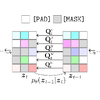
LayoutDM: Discrete Diffusion Model for Controllable Layout
Generation
Naoto Inoue, Kotaro Kikuchi, Edgar Simo-Serra, Mayu Otani, Kota Yamaguchi
Conference in Computer Vision and Pattern Recognition
(CVPR), 2023
Controllable layout generation aims at synthesizing plausible arrangement of
element bounding boxes with optional constraints, such as type or position of a
specific element. In this work, we try to solve a broad range of layout generation
tasks in a single model that is based on discrete state-space diffusion models. Our
model, named LayoutDM, naturally handles the structured layout data in the discrete
representation and learns to progressively infer a noiseless layout from the
initial input, where we model the layout corruption process by modality-wise
discrete diffusion. For conditional generation, we propose to inject layout
constraints in the form of masking or logit adjustment during inference. We show in
the experiments that our LayoutDM successfully generates high-quality layouts and
outperforms both task-specific and task-agnostic baselines on several layout tasks.
@InProceedings{InoueCVPR2023a,
title = {{LayoutDM: Discrete Diffusion Model for Controllable Layout Generation}},
author = {Naoto Inoue and Kotaro Kikuchi and Edgar Simo-Serra and Mayu Otani and Kota Yamaguchi},
booktitle = "Proceedings of the Conference on Computer Vision and Pattern Recognition (CVPR)",
year = 2023,
}
Colorization of line art drawings is an important task in illustration and
animation workflows. However, this highly laborious process is mainly done
manually, limiting the creative productivity. This paper presents a novel
interactive approach for line art colorization using conditional Diffusion
Probabilistic Models (DPMs). In our proposed approach, the user provides initial
color strokes for colorizing the line art. The strokes are then integrated into the
conditional DPM-based colorization process by means of a coupled implicit and
explicit conditioning strategy to generates diverse and high-quality colorized
images. We evaluate our proposal and show it outperforms existing state-of-the-art
approaches using the FID, LPIPS and SSIM metrics.
@InProceedings{CarrilloCVPRW2023,
author = {Hernan Carrillo and Micha\"el Cl/'ement and Aur\'elie Bugeau and Edgar Simo-Serra},
title = {{Diffusart: Enhancing Line Art Colorization with Conditional Diffusion Models}},
booktitle = "Proceedings of the Conference on Computer Vision and Pattern Recognition Workshops (CVPRW)",
year = 2023,
}
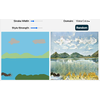
Controllable Multi-domain Semantic Artwork Synthesis
Yuantian Huang, Satoshi Iizuka, Edgar Simo-Serra, Kazuhiro Fukui
Computational Visual Media, 2023
We present a novel framework for multi-domain synthesis of artwork from semantic
layouts. One of the main limitations of this challenging task is the lack of
publicly available segmentation datasets for art synthesis. To address this
problem, we propose a dataset, which we call ArtSem, that contains 40,000 images of
artwork from 4 different domains with their corresponding semantic label maps. We
generate the dataset by first extracting semantic maps from landscape photography
and then propose a conditional Generative Adversarial Network (GAN)-based approach
to generate high-quality artwork from the semantic maps without necessitating
paired training data. Furthermore, we propose an artwork synthesis model that uses
domain-dependent variational encoders for high-quality multi-domain synthesis. The
model is improved and complemented with a simple but effective normalization
method, based on normalizing both the semantic and style jointly, which we call
Spatially STyle-Adaptive Normalization (SSTAN). In contrast to previous methods
that only take semantic layout as input, our model is able to learn a joint
representation of both style and semantic information, which leads to better
generation quality for synthesizing artistic images. Results indicate that our
model learns to separate the domains in the latent space, and thus, by identifying
the hyperplanes that separate the different domains, we can also perform
fine-grained control of the synthesized artwork. By combining our proposed dataset
and approach, we are able to generate user-controllable artwork that is of higher
quality than existing approaches, as corroborated by both quantitative metrics and
a user study.
@Article{HuangCVM2023,
title = {{Controllable Multi-domain Semantic Artwork Synthesis}},
author = {Yuantian Huang and Satoshi Iizuka and Edgar Simo-Serra and Kazuhiro Fukui},
journal = "Computational Visual Media",
year = 2023,
volume = 39,
number = 2,
}
Color is a critical design factor for web pages, affecting important factors such
as viewer emotions and the overall trust and satisfaction of a website. Effective
coloring re- quires design knowledge and expertise, but if this process could be
automated through data-driven modeling, efficient exploration and alternative
workflows would be possible. However, this direction remains underexplored due to
the lack of a formalization of the web page colorization prob- lem, datasets, and
evaluation protocols. In this work, we propose a new dataset consisting of
e-commerce mobile web pages in a tractable format, which are created by simplify-
ing the pages and extracting canonical color styles with a common web browser. The
web page colorization problem is then formalized as a task of estimating plausible
color styles for a given web page content with a given hierarchical structure of
the elements. We present several Transformer- based methods that are adapted to
this task by prepending structural message passing to capture hierarchical
relation- ships between elements. Experimental results, including a quantitative
evaluation designed for this task, demonstrate the advantages of our methods over
statistical and image colorization methods.
@InProceedings{KikuchiWACV2023,
author = {Kotaro Kikuchi and Naoto Inoue and Mayo Otani and Edgar Simo-Serra and Kota Yamaguchi},
title = {{Generative Colorization of Structured Mobile Web Pages}},
booktitle = "Proceedings of the Winter Conference on Applications of Computer Vision (WACV)",
year = 2023,
}
2022
Image Synthesis-based Late Stage Cancer Augmentation and Semi-Supervised
Segmentation for MRI Rectal Cancer Staging
Saeko Sasuga, Akira Kudo, Yoshiro Kitamura, Satoshi Iizuka, Edgar Simo-Serra,
Atsushi Hamabe, Masayuki Ishii, Ichiro Takemasa
International Conference on Medical Image Computing and Computer Assisted
Intervention Workshops (MICCAIW), 2022
Rectal cancer is one of the most common diseases and a major cause of mortality.
For deciding rectal cancer treatment plans, T- staging is important. However,
evaluating the index from preoperative MRI images requires high radiologists’ skill
and experience. Therefore, the aim of this study is to segment the mesorectum,
rectum, and rectal cancer region so that the system can predict T-stage from
segmentation results. Generally, shortage of large and diverse dataset and high
quality an- notation are known to be the bottlenecks in computer aided diagnos-
tics development. Regarding rectal cancer, advanced cancer images are very rare,
and per-pixel annotation requires high radiologists’ skill and time. Therefore, it
is not feasible to collect comprehensive disease pat- terns in a training dataset.
To tackle this, we propose two kinds of ap- proaches of image synthesis-based late
stage cancer augmentation and semi-supervised learning which is designed for
T-stage prediction. In the image synthesis data augmentation approach, we generated
advanced cancer images from labels. The real cancer labels were deformed to re-
semble advanced cancer labels by artificial cancer progress simulation. Next, we
introduce a T-staging loss which enables us to train segmen- tation models from
per-image T-stage labels. The loss works to keep inclusion/invasion relationships
between rectum and cancer region con- sistent to the ground truth T-stage. The
verification tests show that the proposed method obtains the best sensitivity
(0.76) and specificity (0.80) in distinguishing between over T3 stage and underT2.
In the ab- lation studies, our semi-supervised learning approach with the T-staging
loss improved specificity by 0.13. Adding the image synthesis-based data
augmentation improved the DICE score of invasion cancer area by 0.08 from baseline.
We expect that this rectal cancer staging AI can help doctors to diagnose cancer
staging accurately.
@InProceedings{SasugaMICCAIW2022,
author = {Saeko Sasuga and Akira Kudo and Yoshiro Kitamura and Satoshi Iizuka and Edgar Simo-Serra and Atsushi Hamabe and Masayuki Ishii and Ichiro Takemasa},
title = {{Image Synthesis-based Late Stage Cancer Augmentation and Semi-Supervised Segmentation for MRI Rectal Cancer Staging}},
booktitle = "Proceedings of the International Conference on Medical Image Computing and Computer Assisted Intervention Workshops (MICCAIW)",
year = 2022,
}
Dealing with unstructured complex patterns provides a challenge to existing
reinforcement patterns. In this research, we propose a new model to overcome the
difficulty in challenging danmaku games. Touhou Project is one of the best-known
games in the bullet hell genre also known as danmaku, where a player has to dodge
complex patterns of bullets on the screen. Furthermore, the agent needs to react to
the environment in real-time, which made existing methods having difficulties
processing the high-volume data of objects; bullets, enemies, etc. We introduce an
environment for the Touhou Project game 東方花映塚 ~ Phantasmagoria of Flower View which
manipulates the memory of the running game and enables to control the character.
However, the game state information consists of unstructured and unordered data not
amenable for training existing reinforcement learning models, as they are not
invariant to order changes in the input. To overcome this issue, we propose a new
pooling-based reinforcement learning approach that is able to handle permutation
invariant inputs by extracting abstract values and merging them in an
order-independent way. Experimental results corroborate the effectiveness of our
approach which shows significantly increased scores compared to existing baseline
approaches.
@InProceedings{ItoiCOG2022,
author = {Takuto Itoi and Edgar Simo-Serra},
title = {{PIFE: Permutation Invariant Feature Extractor for Danmaku Games}},
booktitle = "Proceedings of the Conference on Games (CoG, Short Oral)",
year = 2022,
}
Beyond a Simple Denoiser: Multi-Domain Adversarial Transformer for
Low-Light Photograph Enhancement
Siyuan Zhu, Edgar Simo-Serra
第22回画像の認識・理解シンポジウム(MIRU), 2022
モバイルWebページの構造的な色付け
菊池 康太郎, 井上 直人, 大谷 まゆ, シモセラエド ガー, 山口 光太
第22回画像の認識・理解シンポジウム(MIRU), 2022
Towards Universal Multi-Modal Layout Models
Naoto Inoue, Kotaro Kikuchi, Edgar Simo-Serra, Mayu Otani, Kota Yamaguchi
第22回画像の認識・理解シンポジウム(MIRU、ロングオーラル), 2022
2021
It is common in graphic design humans visually arrange various elements according
to their design intent and semantics. For example, a title text almost always
appears on top of other elements in a document. In this work, we generate graphic
layouts that can flexibly incorporate such design semantics, either specified
implicitly or explicitly by a user. We optimize using the latent space of an
off-the-shelf layout generation model, allowing our approach to be complementary to
and used with existing layout generation models. Our approach builds on a
generative layout model based on a Transformer architecture, and formulates the
layout generation as a constrained optimization problem where design constraints
are used for element alignment, overlap avoidance, or any other user-specified
relationship. We show in the experiments that our approach is capable of generating
realistic layouts in both constrained and unconstrained generation tasks with a
single model.
@InProceedings{KikuchiMM2021,
author = {Kotaro Kikuchi and Edgar Simo-Serra and Mayu Otani and Kota Yamaguchi},
title = {{Constrained Graphic Layout Generation via Latent Optimization}},
booktitle = "Proceedings of the ACM International Conference on Multimedia (MM)",
year = 2021,
}
Web pages have become fundamental in conveying information for companies and
individuals, yet designing web page layouts remains a challenging task for
inexperienced individuals despite web builders and templates. Visual containment,
in which elements are grouped together and placed inside container elements, is an
efficient design strategy for organizing elements in a limited display, and is
widely implemented in most web page designs. Yet, visual containment has not been
explicitly addressed in the research on generating layouts from scratch, which may
be due to the lack of hierarchical structure. In this work, we represent such
visual containment as a layout tree, and formulate the layout design task as a
hierarchical optimization problem. We first estimate the layout tree from a given a
set of elements, which is then used to compute tree-aware energies corresponding to
various desirable design properties such as alignment or spacing. Using an
optimization approach also allows our method to naturally incorporate user
intentions and create an interactive web design application. We obtain a dataset of
diverse and popular real-world web designs to optimize and evaluate various aspects
of our method. Experimental results show that our method generates better quality
layouts compared to the baseline method.
@Article{KikuchiPG2021,
author = {Kotaro Kikuchi and Edgar Simo-Serra and Mayu Otani and Kota Yamaguchi},
title = {{Modeling Visual Containment for Web Page Layout Optimization}},
journal = {Computer Graphics Forum (Pacific Graphics)},
year = 2021,
}
Exploring Latent Space for Constrained Layout Generation
Kotaro Kikuchi, Edgar Simo-Serra, Mayu Otani, Kota Yamaguchi
Visual Computing (ロングオーラル), 2021
Hierarchical Layout Optimization with Containment-aware
Parameterization
Kotaro Kikuchi, Edgar Simo-Serra, Mayu Otani, Kota Yamaguchi
Visual Computing (ロングオーラル), 2021
Item Management Using Attention Mechanism and Meta Actions in Roguelike
Games
Keisuki Izumiya, Edgar Simo-Serra
Visual Computing (ロングオーラル), 2021
Vector line art plays an important role in graphic design, however, it is tedious
to manually create. We introduce a general framework to produce line drawings from
a wide variety of images, by learning a mapping from raster image space to vector
image space. Our approach is based on a recurrent neural network that draws the
lines one by one. A differentiable rasterization module allows for training with
only supervised raster data. We use a dynamic window around a virtual pen while
drawing lines, implemented with a proposed aligned cropping and differentiable
pasting modules. Furthermore, we develop a stroke regularization loss that
encourages the model to use fewer and longer strokes to simplify the resulting
vector image. Ablation studies and comparisons with existing methods corroborate
the efficiency of our approach which is able to generate visually better results in
less computation time, while generalizing better to a diversity of images and
applications.
@Article{HaoranSIGGRAPH2021,
author = {Haoran Mo and Edgar Simo-Serra and Chengying Gao and Changqing Zou and Ruomei Wang},
title = {{General Virtual Sketching Framework for Vector Line Art}},
journal = "ACM Transactions on Graphics (SIGGRAPH)",
year = 2021,
volume = 40,
number = 4,
}
Masked Transformers for Esports Video Captioning
Tsunehiko Tanaka, Edgar Simo-Serra
画像の認識・理解シンポジウム(MIRU), 2021
High-quality Multi-domain Artwork Generation from Semantic
Layouts
Yuantian Huang, Satoshi Iizuka, Edgar Simo-Serra, Kazuhiro Fukui
画像の認識・理解シンポジウム(MIRU、ショートオーラル), 2021
Self-Supervised Fisheye Image Rectification by Reconstructing Coordinate
Relations
Masaki Hosono, Edgar Simo-Serra, Tomonari Sonoda
画像の認識・理解シンポジウム(MIRU), 2021
With the ascent of wearable camera, dashcam, and autonomous vehicle technology,
fisheye lens cameras are becoming more widespread. Unlike regular cameras, the
videos and images taken with fisheye lens suffer from significant lens distortion,
thus having detrimental effects on image processing algorithms. When the camera
parameters are known, it is straight-forward to correct the distortion, however,
without known camera parameters, distortion correction becomes a non-trivial task.
While learning-based approaches exist, they rely on complex datasets and have
limited generalization. In this work, we propose a CNN-based approach that can be
trained with readily available data. We exploit the fact that relationships between
pixel coordinates remain stable after homogeneous distortions to design an
efficient rectification model. Experiments performed on the cityscapes dataset show
the effectiveness of our approach.
@InProceedings{HosonoMVA2021,
author = {Masaki Hosono and Edgar Simo-Serra and Tomonari Sonoda},
title = {{Unsupervised Deep Fisheye Image Rectification Approach using Coordinate Relations}},
booktitle = "International Conference on Machine Vision Applications (MVA)",
year = 2021,
}
Roguelike games are a challenging environment for Reinforcement Learning (RL)
algorithms due to having to restart the game from the beginning when losing,
randomized procedural generation, and proper use of in-game items being essential
to success. While recent research has proposed roguelike environments for RL
algorithms and proposed models to handle this challenging task, to the best of our
knowledge, none have dealt with the elephant in the room, i.e., handling of items.
Items play a fundamental role in roguelikes and are acquired during gameplay.
However, being an unordered set with a non-fixed amount of elements which form part
of the action space, it is not straightforward to incorporate them into an RL
framework. In this work, we tackle the issue of having unordered sets be part of
the action space and propose an attention-based mechanism that can select and deal
with item-based actions. We also propose a model that can handle complex actions
and items through a meta action framework and evaluate them on the challenging game
of NetHack. Experimental results show that our approach is able to significantly
outperform existing approaches.
@InProceedings{IzumiyaCOG2021,
author = {Keisuke Izumiya and Edgar Simo-Serra},
title = {{Inventory Managament with Attention-Based Meta Actions}},
booktitle = "Proceedings of the Conference on Games (CoG)",
year = 2021,
}
Flat filling is a critical step in digital artistic content creation with the
objective of filling line arts with flat colours. We present a deep learning
framework for user-guided line art flat filling that can compute the "influence
areas" of the user colour scribbles, i.e., the areas where the user scribbles
should propagate and influence. This framework explicitly controls such scribble
influence areas for artists to manipulate the colours of image details and avoid
colour leakage/contamination between scribbles, and simultaneously, leverages
data-driven colour generation to facilitate content creation. This framework is
based on a Split Filling Mechanism (SFM), which first splits the user scribbles
into individual groups and then independently processes the colours and influence
areas of each group with a Convolutional Neural Network (CNN). Learned from more
than a million illustrations, the framework can estimate the scribble influence
areas in a content-aware manner, and can smartly generate visually pleasing colours
to assist the daily works of artists. We show that our proposed framework is easy
to use, allowing even amateurs to obtain professional-quality results on a wide
variety of line arts.
@InProceedings{ZhangCVPR2021,
author = {Lvmin Zhang and Chengze Li and Edgar Simo-Serra and Yi Ji and Tien-Tsin Wong and Chunping Liu},
title = {{User-Guided Line Art Flat Filling with Split Filling Mechanism}},
booktitle = "Proceedings of the Conference on Computer Vision and Pattern Recognition (CVPR)",
year = 2021,
}
Line art plays a fundamental role in illustration and design, and allows for
iteratively polishing designs. However, as they lack color, they can have issues in
conveying final designs. In this work, we propose an interactive colorization
approach based on a conditional generative adversarial network that takes both the
line art and color hints as inputs to produce a high-quality colorized image. Our
approach is based on a U-net architecture with a multi-discriminator framework. We
propose a Concatenation and Spatial Attention module that is able to generate more
consistent and higher quality of line art colorization from user given hints. We
evaluate on a large-scale illustration dataset and comparison with existing
approaches corroborate the effectiveness of our approach.
@InProceedings{YuanCVPRW2021,
author = {Mingcheng Yuan and Edgar Simo-Serra},
title = {{Line Art Colorization with Concatenated Spatial Attention}},
booktitle = "Proceedings of the Conference on Computer Vision and Pattern Recognition Workshops (CVPRW)",
year = 2021,
}
Esports is a fastest-growing new field with a largely online-presence, and is
creating a demand for automatic domain-specific captioning tools. However, at the
current time, there are few approaches that tackle the esports video description
problem. In this work, we propose a large-scale dataset for esports video
description, focusing on the popular game "League of Legends". The dataset, which
we call LoL-V2T, is the largest video description dataset in the vldeo game domain,
and includes 9,723 clips with 62,677 captions. This new dataset presents multiple
new video captioning challenges such as large amounts of domain-specific
vocabulary, subtle motions with large importance, and a temporal gap between most
captions and the events that occurred. In order to tackle the issue of vocabulary,
we propose a masking the domain-specific words and provide additional annotations
for this. In our results, we show that the dataset poses a challenge to existing
video captioning approaches, and the masking can significantly improve performance.
@InProceedings{TanakaCVPRW2021,
author = {Tsunehiko Tanaka and Edgar Simo-Serra},
title = {{LoL-V2T: Large-Scale Esports Video Description Dataset}},
booktitle = "Proceedings of the Conference on Computer Vision and Pattern Recognition Workshops (CVPRW)",
year = 2021,
}
Conditional human image generation, or generation of human images with specified
pose based on one or more reference images, is an inherently ill-defined problem,
as there can be multiple plausible appearance for parts that are occluded in the
reference. Using multiple images can mitigate this problem while boosting the
performance. In this work, we introduce a differentiable vertex and edge renderer
for incorporating the pose information to realize human image generation
conditioned on multiple reference images. The differentiable renderer has
parameters that can be jointly optimized with other parts of the system to obtain
better results by learning more meaningful shape representation of human pose. We
evaluate our method on the Market-1501 and DeepFashion datasets and comparison with
existing approaches validates the effectiveness of our approach.
@InProceedings{HoriuchiCVPRW2021,
author = {Yusuke Horiuchi and Edgar Simo-Serra and Satoshi Iizuka and Hiroshi Ishikawa},
title = {{Differentiable Rendering-based Pose-Conditioned Human Image Generation}},
booktitle = "Proceedings of the Conference on Computer Vision and Pattern Recognition Workshops (CVPRW)",
year = 2021,
}
2020
P²Net: A Post-Processing Network for Refining Semantic Segmentation of
LiDAR Point Cloud based on Consistency of Consecutive Frames
Yutaka Momma, Weimin Wang, Edgar Simo-Serra, Satoshi Iizuka, Ryosuke Nakamura,
Hiroshi Ishikawa
IEEE International Conference on Systems, Man, and Cybernetics, 2020
We present a lightweight post-processing method to refine the semantic segmentation
results of point cloud sequences. Most existing methods usually segment frame by
frame and encounter the inherent ambiguity of the problem: based on a measurement
in a single frame, labels are sometimes difficult to predict even for humans. To
remedy this problem, we propose to explicitly train a network to refine these
results predicted by an existing segmentation method. The network, which we call
the P²Net, learns the consistency constraints between "coincident" points from
consecutive frames after registration. We evaluate the proposed post-processing
method both qualitatively and quantitatively on the SemanticKITTI dataset that
consists of real outdoor scenes. The effectiveness of the proposed method is
validated by comparing the results predicted by two representative networks with
and without the refinement by the post-processing network. Specifically,
qualitative visualization validates the key idea that labels of the points that are
difficult to predict can be corrected with P²NNet. Quantitatively, overall mIoU is
improved from 10.5% to 11.7% for PointNet and from 10.8% to 15.9% for PointNet++.
@InProceedings{MommaSMC2020,
author = {Yutaka Momma and Weimin Wang and Edgar Simo-Serra and Satoshi Iizuka and Ryosuke Nakamura and Hiroshi Ishikawa},
title = {{P²Net: A Post-Processing Network for Refining Semantic Segmentation of LiDAR Point Cloud based on Consistency of Consecutive Frames}},
booktitle = "Proceedings of the IEEE International Conference on Systems, Man, and Cybernetics (SMC)",
year = 2020,
}
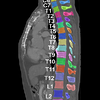
Automatic Segmentation, Localization and Identification of Vertebrae in
3D CT Images Using Cascaded Convolutional Neural Networks
Naoto Masuzawa, Yoshiro Kitamura, Keigo Nakamura, Satoshi Iizuka, Edgar
Simo-Serra
International Conference on Medical Image Computing and Computer
Assisted Intervention (MICCAI), 2020
This paper presents a method for automatic segmentation, localization, and
identification of vertebrae in arbitrary 3D CT images. Many previous works do not
perform the three tasks simultaneously even though requiring a priori knowledge of
which part of the anatomy is visible in the 3D CT images. Our method tackles all
these tasks in a single multi-stage framework without any assumptions. In the first
stage, we train a 3D Fully Convolutional Networks to find the bounding box of the
cervical, thoracic, and lumbar vertebrae. In the second stage, we train an
iterative 3D Fully Convolutional Networks to segment individual vertebrae in the
bounding box. The input to the second network has an auxiliary channel in addition
to the 3D CT images. Given the segmented vertebrae regions in the auxiliary
channel, the network output the next vertebra. The proposed method is evaluated in
terms of segmentation, localization and identification accuracy with two public
datasets of 15 3D CT images from the MICCAI CSI 2014 workshop challenge and 302 3D
CT images with various pathologies. Our method achieved a mean Dice score of 96%, a
mean localization error of 8.3 mm, and a mean identification rate of 84%. In
summary, our method achieved better performance than all existing works in all the
three metrics.
@InProceedings{MasuzawaMICCAI2020,
author = {Naoto Masuzawa and Yoshiro Kitamura and Keigo Nakamura and Satoshi Iizuka and Edgar Simo-Serra},
title = {{Automatic Segmentation, Localization and Identification of Vertebrae in 3D CT Images Using Cascaded Convolutional Neural Networks}},
booktitle = "Proceedings of the International Conference on Medical Image Computing and Computer Assisted Intervention (MICCAI)",
year = 2020,
}

TopNet: Topology Preserving Metric Learning for Vessel Tree
Reconstruction and Labelling
Deepak Keshwani, Yoshiro Kitamura, Satoshi Ihara, Satoshi Iizuka, Edgar
Simo-Serra
International Conference on Medical Image Computing and Computer
Assisted Intervention (MICCAI), 2020
Reconstructing Portal Vein and Hepatic Vein trees from contrast enhanced abdominal
CT scans is a prerequisite for preoperative liver surgery simulation. Existing deep
learning based methods treat vascular tree reconstruction as a semantic
segmentation problem. However, vessels such as hepatic and portal vein look very
similar locally and need to be traced to their source for robust label assignment.
Therefore, semantic segmentation by looking at local 3D patch results in noisy
misclassifications. To tackle this, we propose a novel multi-task deep learning
architecture for vessel tree reconstruction. The network architecture
simultaneously solves the task of detecting voxels on vascular centerlines (i.e.
nodes) and estimates connectivity between center-voxels (edges) in the tree
structure to be reconstructed. Further, we propose a novel connectivity metric
which considers both inter-class distance and intra-class topological distance
between center-voxel pairs. Vascular trees are reconstructed starting from the
vessel source using the learned connectivity metric using the shortest path tree
algorithm. A thorough evaluation on public IRCAD dataset shows that the proposed
method considerably outperforms existing semantic segmentation based methods. To
the best of our knowledge, this is the first deep learning based approach which
learns multi-label tree structure connectivity from images.
@InProceedings{KeshwaniMICCAI2020,
author = {Deepak Keshwani and Yoshiro Kitamura and Satoshi Ihara and Satoshi Iizuka and Edgar Simo-Serra},
title = {{TopNet: Topology Preserving Metric Learning for Vessel Tree Reconstruction and Labelling}},
booktitle = "Proceedings of the International Conference on Medical Image Computing and Computer Assisted Intervention (MICCAI)",
year = 2020,
}
We propose an efficient pipeline for large-scale landmark image retrieval that
addresses the diversity of the dataset through two-stage discriminative re-ranking.
Our approach is based on embedding the images in a feature-space using a
convolutional neural network trained with a cosine softmax loss. Due to the
variance of the images, which include extreme viewpoint changes such as having to
retrieve images of the exterior of a landmark from images of the interior, this is
very challenging for approaches based exclusively on visual similarity. Our
proposed re-ranking approach improves the results in two steps: in the sort-step,
k-nearest neighbor search with soft-voting to sort the retrieved results based on
their label similarity to the query images, and in the insert-step, we add
additional samples from the dataset that were not retrieved by image-similarity.
This approach allows overcoming the low visual diversity in retrieved images.
In-depth experimental results show that the proposed approach significantly
outperforms existing approaches on the challenging Google Landmarks Datasets. Using
our methods, we achieved 1st place in the Google Landmark Retrieval 2019 challenge
on Kaggle.
@InProceedings{YokooCVPRW2020,
author = {Shuhei Yokoo and Kohei Ozaki and Edgar Simo-Serra and Satoshi Iizuka},
title = {{Two-stage Discriminative Re-ranking for Large-scale Landmark Retrieval}},
booktitle = "Proceedings of the Conference on Computer Vision and Pattern Recognition Workshops (CVPRW)",
year = 2020,
}
We present an algorithm to generate digital painting lighting effects from a single
image. Our algorithm is based on a key observation: artists use many overlapping
strokes to paint lighting effects, i.e., pixels with dense stroke history tend to
gather more illumination strokes. Based on this observation, we design an algorithm
to both estimate the density of strokes in a digital painting using color geometry,
and then generate novel lighting effects by mimicking artists' coarse-to-fine
workflow. Coarse lighting effects are first generated using a wave transform, and
then retouched according to the stroke density of the original illustrations into
usable lighting effects.
Our algorithm is content-aware, with generated lighting effects naturally adapting to image structures, and can be used as an interactive tool to simplify current labor-intensive workflows for generating lighting effects for digital and matte paintings. In addition, our algorithm can also produce usable lighting effects for photographs or 3D rendered images. We evaluate our approach with both an in-depth qualitative and a quantitative analysis which includes a perceptual user study. Results show that our proposed approach is not only able to produce favorable lighting effects with respect to existing approaches, but also that it is able to significantly reduce the needed interaction time.
Our algorithm is content-aware, with generated lighting effects naturally adapting to image structures, and can be used as an interactive tool to simplify current labor-intensive workflows for generating lighting effects for digital and matte paintings. In addition, our algorithm can also produce usable lighting effects for photographs or 3D rendered images. We evaluate our approach with both an in-depth qualitative and a quantitative analysis which includes a perceptual user study. Results show that our proposed approach is not only able to produce favorable lighting effects with respect to existing approaches, but also that it is able to significantly reduce the needed interaction time.
@Article{ZhangTOG2020,
author = {Lvmin Zhang and Edgar Simo-Serra and Yi Ji and Chunping Liu},
title = {{Generating Digital Painting Lighting Effects via RGB-space Geometry}},
journal = "Transactions on Graphics (Presented at SIGGRAPH)",
year = 2020,
volume = 39,
number = 2,
}
2019
The remastering of vintage film comprises of a diversity of sub-tasks including
super-resolution, noise removal, and contrast enhancement which aim to restore the
deteriorated film medium to its original state. Additionally, due to the technical
limitations of the time, most vintage film is either recorded in black and white,
or has low quality colors, for which colorization becomes necessary. In this work,
we propose a single framework to tackle the entire remastering task
semi-interactively. Our work is based on temporal convolutional neural networks
with attention mechanisms trained on videos with data-driven deterioration
simulation. Our proposed source-reference attention allows the model to handle an
arbitrary number of reference color images to colorize long videos without the need
for segmentation while maintaining temporal consistency. Quantitative analysis
shows that our framework outperforms existing approaches, and that, in contrast to
existing approaches, the performance of our framework increases with longer videos
and more reference color images.
@Article{IizukaSIGGRAPHASIA2019,
author = {Satoshi Iizuka and Edgar Simo-Serra},
title = {{DeepRemaster: Temporal Source-Reference Attention Networks for Comprehensive Video Enhancement}},
journal = "ACM Transactions on Graphics (SIGGRAPH Asia)",
year = 2019,
volume = 38,
number = 6,
}
Spatially placing an object onto a background is an essential operation in graphic
design and facilitates many different applications such as virtual try-on. The
placing operation is formulated as a geometric inference problem for given
foreground and background images, and has been approached by spatial transformer
architecture.In this paper, we propose a simple yet effective regularization
technique to guide the geometric parameters based on user-defined trust regions.
Our approach stabilizes the training process of spatial transformer networks and
achieves a high-quality prediction with single-shot inference. Our proposed method
is independent of initial parameters, and can easily incorporate various priors to
prevent different types of trivial solutions. Empirical evaluation with the
Abstract Scenes and CelebA datasets shows that our approach achieves favorable
results compared to baselines.
@InProceedings{KikuchiICCVW2019,
author = {Kotaro Kikuchi and Kota Yamaguchi and Edgar Simo-Serra and Tetsunori Kobayashi},
title = {{Regularized Adversarial Training for Single-shot Virtual Try-On}},
booktitle = "Proceedings of the International Conference on Computer Vision Workshops (ICCVW)",
year = 2019,
}
ImageNet pre-training has been regarded as essential for training accurate object
detectors for a long time. Recently, it has been shown that object detectors
trained from randomly initialized weights can be on par with those fine-tuned from
ImageNet pre-trained models. However, effect of pre-training and the differences
caused by pre-training are still not fully understood. In this paper, we analyze
the eigenspectrum dynamics of the covariance matrix of each feature map in object
detectors. Based on our analysis on ResNet-50, Faster R-CNN with FPN, and Mask
R-CNN, we show that object detectors trained from ImageNet pre-trained models and
those trained from scratch behave differently from each other even if both object
detectors have similar accuracy. Furthermore, we propose a method for automatically
determining the widths (the numbers of channels) of object detectors based on the
eigenspectrum. We train Faster R-CNN with FPN from randomly initialized weights,
and show that our method can reduce ~27% of the parameters of ResNet-50 without
increasing Multiply-Accumulate operations (MACs) and losing accuracy. Our results
indicate that we should develop more appropriate methods for transferring knowledge
from image classification to object detection (or other tasks).
@InProceedings{ShinyaICCVW2019,
author = {Yosuke Shinya and Edgar Simo-Serra and Taiji Suzuki},
title = {{Understanding the Effects of Pre-training for Object Detectors via Eigenspectrum}},
booktitle = "Proceedings of the International Conference on Computer Vision Workshops (ICCVW)",
year = 2019,
}
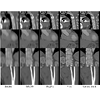
Virtual Thin Slice: 3D Conditional GAN-based Super-resolution for CT
Slice Interval
Akira Kudo, Yoshiro Kitamura, Yuanzhong Li, Satoshi Iizuka, Edgar Simo-Serra
International Conference on Medical Image Computing and Computer Assisted
Intervention Workshops (MICCAIW), 2019
Many CT slice images are stored with large slice intervals to reduce storage size
in clinical practice. This leads to low resolution perpendicular to the slice
images (i.e., z-axis), which is insufficient for 3D visualization or image
analysis. In this paper, we present a novel architecture based on conditional
Generative Adversarial Networks (cGANs) with the goal of generating high resolution
images of main body parts including head, chest, abdomen and legs. However, GANs
are known to have a difficulty with generating a diversity of patterns due to a
phenomena known as mode collapse. To overcome the lack of generated pattern
variety, we propose to condition the discriminator on the different body parts.
Furthermore, our generator networks are extended to be three dimensional fully
convolutional neural networks, allowing for the generation of high resolution
images from arbitrary fields of view. In our verification tests, we show that the
proposed method obtains the best scores by PSNR/SSIM metrics and Visual Turing
Test, allowing for accurate reproduction of the principle anatomy in high
resolution. We expect that the proposed method contribute to effective utilization
of the existing vast amounts of thick CT images stored in hospitals.
@InProceedings{KudoMICCAIW2019,
author = {Akira Kudo and Yoshiro Kitamura and Yuanzhong Li and Satoshi Iizuka and Edgar Simo-Serra},
title = {{Virtual Thin Slice: 3D Conditional GAN-based Super-resolution for CT Slice Interval}},
booktitle = "Proceedings of the International Conference on Medical Image Computing and Computer Assisted Intervention Workshops (MICCAIW)",
year = 2019,
}
固有値分布に基づく物体検出CNNの事前学習効果の分析
進矢 陽介, シモセラ エドガー, 鈴木 大慈
第22回画像の認識・理解シンポジウム(MIRU), 2019
Temporal Distance Matrices for Workout Form Assessment
Ryoji Ogata, Edgar Simo-Serra, Satoshi Iizuka, Hiroshi Ishikawa
第22回画像の認識・理解シンポジウム(MIRU、ショートオーラル), 2019
Regularizing Adversarial Training for Single-shot Object
Placement
Kotaro Kikuchi, Kota Yamaguchi, Edgar Simo-Serra, Tetsunori Kobayashi
第22回画像の認識・理解シンポジウム(MIRU、ショートオーラル), 2019
DeepRemaster: Temporal Source-Reference
Attentionを用いた動画のデジタルリマスター
飯塚 里志,シモセラ エドガー
Visual Computing / グラフィクスとCAD 合同シンポジウム(オーラル) [最優秀研究発表賞], 2019
The preparation of large amounts of high-quality training data has always been the
bottleneck for the performance of supervised learning methods. It is especially
time-consuming for complicated tasks such as photo enhancement. A recent approach
to ease data annotation creates realistic training data automatically with
optimization. In this paper, we improve upon this approach by learning
image-similarity which, in combination with a Covariance Matrix Adaptation
optimization method, allows us to create higher quality training data for enhancing
photos. We evaluate our approach on challenging real world photo-enhancement images
by conducting a perceptual user study, which shows that its performance compares
favorably with existing approaches.
@InProceedings{OmiyaCVPRW2019,
author = {Mayu Omiya and Yusuke Horiuchi and Edgar Simo-Serra and Satoshi Iizuka and Hiroshi Ishikawa},
title = {{Optimization-Based Data Generation for Photo Enhancement}},
booktitle = "Proceedings of the Conference on Computer Vision and Pattern Recognition Workshops (CVPRW)",
year = 2019,
}

Temporal Distance Matrices for Squat Classification
Ryoji Ogata, Edgar Simo-Serra, Satoshi Iizuka, Hiroshi Ishikawa
Conference in Computer Vision and Pattern Recognition Workshops (CVPRW),
2019
When working out, it is necessary to perform the same action many times for it to
have effect. If the action, such as squats or bench pressing, is performed with
poor form, it can lead to serious injuries in the long term. For this purpose, we
present an action dataset of squats where different types of poor form have been
annotated with a diversity of users and backgrounds, and propose a model, based on
temporal distance matrices, for the classification task. We first run a 3D pose
detector, then we normalize the pose and compute the distance matrix, in which each
element represents the distance between two joints. This representation is
invariant to differences in individuals, global translation, and global rotation,
allowing for high generalization to real world data. Our classification model
consists of a CNN with 1D convolutions. Results show that our method significantly
outperforms existing approaches for the task.
@InProceedings{OgataCVPRW2019,
author = {Ryoji Ogata and Edgar Simo-Serra and Satoshi Iizuka and Hiroshi Ishikawa},
title = {{Temporal Distance Matrices for Squat Classification}},
booktitle = "Proceedings of the Conference on Computer Vision and Pattern Recognition Workshops (CVPRW)",
year = 2019,
}
We address the problem of conditional image generation of synthesizing a new image
of an individual given a reference image and target pose. We base our approach on
generative adversarial networks and leverage deformable skip connections to deal
with pixel-to-pixel misalignments, self-attention to leverage complementary
features in separate portions of the image, e.g., arms or legs, and spectral
normalization to improve the quality of the synthesized images. We train the
synthesis model with a nearest-neighbour loss in combination with a relativistic
average hinge adversarial loss. We evaluate on the Market-1501 dataset and show how
our proposed approach can surpass existing approaches in conditional image
synthesis performance.
@InProceedings{HoriuchiMVA2019,
author = {Yusuke Horiuchi and Edgar Simo-Serra and Satoshi Iizuka and Hiroshi Ishikawa},
title = {{Spectral Normalization and Relativistic Adversarial Training for Conditional Pose Generation with Self-Attention}},
booktitle = "International Conference on Machine Vision Applications (MVA)",
year = 2019,
}
Re-staining Pathology Images by FCNN
Masayuki Fujitani, Yoshihiko Mochizuki, Satoshi Iizuka, Edgar Simo-Serra,
Hirokazu Kobayashi, Chika Iwamoto, Kenoki Ohuchida, Makoto Hashizume, Hidekata
Hontani, Hiroshi Ishikawa
International Conference on Machine Vision Applications (MVA), 2019
In histopathology, pathologic tissue samples are stained using one of various
techniques according to the desired features to be observed in microscopic
examination. One problem is that staining is irreversible. Once a tissue slice is
stained using a technique, it cannot be re-stained using another. In this work, we
propose a method for simulated re-staining using a Fully Convolutional Neural
Network (FCNN).We convert a digitally scanned pathology image of a sample, stained
using one technique, into another image with a different simulated stain. The
challenge is that the ground truth cannot be obtained: the network needs training
data, which in this case would be pairs of images of a sample stained in two
different techniques. We overcome this problem by using the images of consecutive
slices that are stained using the two distinct techniques, screening for
morphological similarity by comparing their density components in the HSD color
space. We demonstrate the effectiveness of the method in the case of converting
hematoxylin and eosin-stained images into Masson’s trichrome stained images.
@InProceedings{FujitaniMVA2019,
author = {Masayuki Fujitani and Yoshihiko Mochizuki and Satoshi Iizuka and Edgar Simo-Serra and Hirokazu Kobayashi and Chika Iwamoto and Kenoki Ohuchida and Makoto Hashizume and Hidekata Hontani and Hiroshi Ishikawa},
title = {{Re-staining Pathology Images by FCNN}},
booktitle = "International Conference on Machine Vision Applications (MVA, Oral)",
year = 2019,
}
2018
We address the problem of automatic photo enhancement, in which the challenge is to
determine the optimal enhancement for a given photo according to its content. For
this purpose, we train a convolutional neural network to predict the best
enhancement for given picture. While such machine learning techniques have shown
great promise in photo enhancement, there are some limitations. One is the problem
of interpretability, i.e., that it is not easy for the user to discern what has
been done by a machine. In this work, we leverage existing manual photo enhancement
tools as a black-box model, and predict the enhancement parameters of that model.
Because the tools are designed for human use, the resulting parameters can be
interpreted by their users. Another problem is the difficulty of obtaining training
data. We propose generating supervised training data from high-quality professional
images by randomly sampling realistic de-enhancement parameters. We show that this
approach allows automatic enhancement of photographs without the need for large
manually labelled supervised training datasets.
@InProceedings{OmiyaSIGGRAPASIABRIEF2018,
author = {Mayu Omiya and Edgar Simo-Serra and Satoshi Iizuka and Hiroshi Ishikawa},
title = {{Learning Photo Enhancement by Black-Box Model Optimization Data Generation}},
booktitle = "SIGGRAPH Asia 2018 Technical Briefs",
year = 2018,
}
We present an interactive approach for inking, which is the process of turning a
pencil rough sketch into a clean line drawing. The approach, which we call the
Smart Inker, consists of several "smart" tools that intuitively react to user
input, while guided by the input rough sketch, to efficiently and naturally connect
lines, erase shading, and fine-tune the line drawing output. Our approach is
data-driven: the tools are based on fully convolutional networks, which we train to
exploit both the user edits and inaccurate rough sketch to produce accurate line
drawings, allowing high-performance interactive editing in real-time on a variety
of challenging rough sketch images. For the training of the tools, we developed two
key techniques: one is the creation of training data by simulation of vague and
quick user edits; the other is a line normalization based on learning from vector
data. These techniques, in combination with our sketch-specific data augmentation,
allow us to train the tools on heterogeneous data without actual user interaction.
We validate our approach with an in-depth user study, comparing it with
professional illustration software, and show that our approach is able to reduce
inking time by a factor of 1.8x while improving the results of amateur users.
@Article{SimoSerraSIGGRAPH2018,
author = {Edgar Simo-Serra and Satoshi Iizuka and Hiroshi Ishikawa},
title = {{Real-Time Data-Driven Interactive Rough Sketch Inking}},
journal = "ACM Transactions on Graphics (SIGGRAPH)",
year = 2018,
volume = 37,
number = 4,
}
再帰型畳み込みニューラルネットワークによる航空写真の多クラスセグメンテーション
高橋 宏輝,飯塚 里志,シモセラ エドガー,石川 博
第21回画像の認識・理解シンポジウム(MIRU), 2018
背景と反射成分の同時推定による画像の映り込み除去
佐藤 良亮,飯塚 里志,シモセラ エドガー,石川 博
第21回画像の認識・理解シンポジウム(MIRU、オーラル) [学生奨励賞], 2018
補正パラメータ学習による写真の高品質自動補正
近江谷 真由,シモセラ エドガー,飯塚 里志,石川 博
第21回画像の認識・理解シンポジウム(MIRU), 2018
SSDによる郵便物ラベルの認識及び高速化
尾形 亮二,望月 義彦,飯塚 里志,シモセラ エドガー,石川 博
第21回画像の認識・理解シンポジウム(MIRU), 2018
FCNNを用いた病理画像の染色変換
藤谷 真之,望月 義彦,飯塚 里志,シモセラ エドガー,小林 裕和,岩本 千佳,大内田 研宙,橋爪 誠,本谷 秀堅,石川 博
第21回画像の認識・理解シンポジウム(MIRU、オーラル) [学生奨励賞], 2018
We propose a fully automatic approach to restore aged old line drawings. We
decompose the task into two subtasks: the line extraction subtask, which aims to
extract line fragments and remove the paper texture background, and the restoration
subtask, which fills in possible gaps and deterioration of the lines to produce a
clean line drawing. Our approach is based on a convolutional neural network that
consists of two sub-networks corresponding to the two subtasks. They are trained as
part of a single framework in an end-to-end fashion. We also introduce a new
dataset consisting of manually annotated sketches by Leonardo da Vinci which, in
combination with a synthetic data generation approach, allows training the network
to restore deteriorated line drawings. We evaluate our method on challenging
500-year-old sketches and compare with existing approaches with a user study, in
which it is found that our approach is preferred 72.7% of the time.
@Article{SasakiCGI2018,
author = {Sasaki Kazuma and Satoshi Iizuka and Edgar Simo-Serra and Hiroshi Ishikawa}},
title = {{Learning to Restore Deteriorated Line Drawing}},
journal = "The Visual Computer (Proc. of Computer Graphics International)",
year = {2018},
volume = {34},
pages = {1077--1085},
}
特集「漫画・線画の画像処理」ラフスケッチの自動線画化技術
シモセラ エドガー,飯塚 里志
映像情報メディア学会誌2018年5月号, 2018
We present an integral framework for training sketch simplification networks that
convert challenging rough sketches into clean line drawings. Our approach augments
a simplification network with a discriminator network, training both networks
jointly so that the discriminator network discerns whether a line drawing is a real
training data or the output of the simplification network, which in turn tries to
fool it. This approach has two major advantages. First, because the discriminator
network learns the structure in line drawings, it encourages the output sketches of
the simplification network to be more similar in appearance to the training
sketches. Second, we can also train the simplification network with additional
unsupervised data, using the discriminator network as a substitute teacher. Thus,
by adding only rough sketches without simplified line drawings, or only line
drawings without the original rough sketches, we can improve the quality of the
sketch simplification. We show how our framework can be used to train models that
significantly outperform the state of the art in the sketch simplification task,
despite using the same architecture for inference. We additionally present an
approach to optimize for a single image, which improves accuracy at the cost of
additional computation time. Finally, we show that, using the same framework, it is
possible to train the network to perform the inverse problem, i.e., convert simple
line sketches into pencil drawings, which is not possible using the standard mean
squared error loss. We validate our framework with two user tests, where our
approach is preferred to the state of the art in sketch simplification 92.3% of the
time and obtains 1.2 more points on a scale of 1 to 5.
@Article{SimoSerraTOG2018,
author = {Edgar Simo-Serra and Satoshi Iizuka and Hiroshi Ishikawa},
title = {{Mastering Sketching: Adversarial Augmentation for Structured Prediction}},
journal = "Transactions on Graphics (Presented at SIGGRAPH)",
year = 2018,
volume = 37,
number = 1,
}
2017
Content-aware image resizing aims to reduce the size of an image without touching
important objects and regions. In seam carving, this is done by assessing the
importance of each pixel by an energy function and repeatedly removing a string of
pixels avoiding pixels with high energy. However, there is no single energy
function that is best for all images: the optimal energy function is itself a
function of the image. In this paper, we present a method for predicting the
quality of the results of resizing an image with different energy functions, so as
to select the energy best suited for that particular image. We formulate the
selection as a classification problem; i.e., we 'classify' the input into the class
of images for which one of the energies works best. The standard approach would be
to use a CNN for the classification. However, the existence of a fully connected
layer forces us to resize the input to a fixed size, which obliterates useful
information, especially lower-level features that more closely relate to the
energies used for seam carving. Instead, we extract a feature from internal
convolutional layers, which results in a fixed-length vector regardless of the
input size, making it amenable to classification with a Support Vector Machine.
This formulation of the algorithm selection as a classification problem can be used
whenever there are multiple approaches for a specific image processing task. We
validate our approach with a user study, where our method outperforms recent seam
carving approaches.
@InProceedings{SasakiACPR2017,
author = {Kazuma Sasaki and Yuya Nagahama and Zheng Ze and Satoshi Iizuka and Edgar Simo-Serra and Yoshihiko Mochizuki and Hiroshi Ishikawa},
title = {{Adaptive Energy Selection For Content-Aware Image Resizing}},
booktitle = "Proceedings of the Asian Conference on Pattern Recognition (ACPR)",
year = 2017,
}
画像類似度を考慮したデータセットを用いて学習したCNNによる病理画像の染色変換
藤谷 真之,望月 義彦,飯塚 里志,シモセラ エドガー,石川 博
ヘルスケア・医療情報通信技術研究会(MICT), 2017
In this work, we perform an experimental analysis of the differences of both how
humans and machines see and distinguish fashion styles. For this purpose, we
propose an expert-curated new dataset for fashion style prediction, which consists
of 14 different fashion styles each with roughly 1,000 images of worn outfits. The
dataset, with a total of 13,126 images, captures the diversity and complexity of
modern fashion styles. We perform an extensive analysis of the dataset by
benchmarking a wide variety of modern classification networks, and also perform an
in-depth user study with both fashion-savvy and fashion-naive users. Our results
indicate that, although classification networks are able to outperform naive users,
they are still far from the performance of savvy users, for which it is important
to not only consider texture and color, but subtle differences in the combination
of garments.
@InProceedings{TakagiICCVW2017,
author = {Moeko Takagi and Edgar Simo-Serra and Satoshi Iizuka and Hiroshi Ishikawa},
title = {{What Makes a Style: Experimental Analysis of Fashion Prediction}},
booktitle = "Proceedings of the International Conference on Computer Vision Workshops (ICCVW)",
year = 2017,
}
We present an approach to detect the main product in fashion images by exploiting
the textual metadata associated with each image. Our approach is based on a
Convolutional Neural Network and learns a joint embedding of object proposals and
textual metadata to predict the main product in the image. We additionally use
several complementary classification and overlap losses in order to improve
training stability and performance. Our tests on a large-scale dataset taken from
eight e-commerce sites show that our approach outperforms strong baselines and is
able to accurately detect the main product in a wide diversity of challenging
fashion images.
@InProceedings{RubioICCVW2017,
author = {Antonio Rubio and Longlong Yu and Edgar Simo-Serra and Francesc Moreno-Noguer},
title = {{Multi-Modal Embedding for Main Product Detection in Fashion}},
booktitle = "Proceedings of the International Conference on Computer Vision Workshops (ICCVW)",
year = 2017,
}
We tackle the problem of multi-label classification of fashion images from noisy
data using minimal human supervision. We present a new dataset of full body poses,
each with a set of 66 binary labels corresponding to information about the garments
worn in the image and obtained in an automatic manner. As the automatically
collected labels contain significant noise, for a small subset of the data, we
manually correct the labels, using these correct labels for further training and
evaluating the model. We build upon a recent approach that both cleans the noisy
labels while learning to classify, and show simple changes that can significantly
improve the performance.
@InProceedings{InoueICCVW2017,
author = {Naoto Inoue and Edgar Simo-Serra and Toshihiko Yamasaki and Hiroshi Ishikawa},
title = {{Multi-Label Fashion Image Classification with Minimal Human Supervision}},
booktitle = "Proceedings of the International Conference on Computer Vision Workshops (ICCVW)",
year = 2017,
}
Finding a product in the fashion world can be a daunting task. Everyday, e-commerce
sites are updating with thousands of images and their associated metadata (textual
information), deepening the problem, akin to finding a needle in a haystack. In
this paper, we leverage both the images and textual metadata and propose a joint
multi-modal embedding that maps both the text and images into a common latent
space. Distances in the latent space correspond to similarity between products,
allowing us to effectively perform retrieval in this latent space, which is both
efficient and accurate. We train this embedding using large-scale real world
e-commerce data by both minimizing the similarity between related products and
using auxiliary classification networks to that encourage the embedding to have
semantic meaning. We compare against existing approaches and show significant
improvements in retrieval tasks on a large-scale e-commerce dataset. We also
provide an analysis of the different metadata.
@InProceedings{RubioICIP2017,
author = {Antonio Rubio and Longlong Yu and Edgar Simo-Serra and Francesc Moreno-Noguer},
title = {{Multi-Modal Joint Embedding for Fashion Product Retrieval}},
booktitle = "International Conference on Image Processing (ICIP)",
year = 2017,
}
再帰構造を用いた全層畳み込みニューラルネットワークによる航空写真における建物のセグメンテーション
高橋 宏輝,飯塚 里志,シモセラ エドガー,石川 博
第20回画像の認識・理解シンポジウム(MIRU、オーラル) [学生奨励賞], 2017
ディープラーニングによるファッションコーディネートの分類
高木 萌子,シモセラ エドガー,飯塚 里志,石川 博
第20回画像の認識・理解シンポジウム(MIRU), 2017
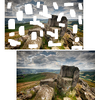
Globally and Locally Consistent Image Completion
Satoshi Iizuka, Edgar Simo-Serra, Hiroshi Ishikawa
ACM Transactions on Graphics (SIGGRAPH), 2017
We present a novel approach for image completion that results in images that are
both locally and globally consistent. With a fully-convolutional neural network, we
can complete images of arbitrary resolutions by filling-in missing regions of any
shape. To train this image completion network to be consistent, we use global and
local context discriminators that are trained to distinguish real images from
completed ones. The global discriminator looks at the entire image to assess if it
is coherent as a whole, while the local discriminator looks only at a small area
centered at the completed region to ensure the local consistency of the generated
patches. The image completion network is then trained to fool the both context
discriminator networks, which requires it to generate images that are
indistinguishable from real ones with regard to overall consistency as well as in
details. We show that our approach can be used to complete a wide variety of
scenes. Furthermore, in contrast with the patch-based approaches such as
PatchMatch, our approach can generate fragments that do not appear elsewhere in the
image, which allows us to naturally complete the images of objects with familiar
and highly specific structures, such as faces.
@Article{IizukaSIGGRAPH2017,
author = {Satoshi Iizuka and Edgar Simo-Serra and Hiroshi Ishikawa},
title = {{Globally and Locally Consistent Image Completion}},
journal = "ACM Transactions on Graphics (SIGGRAPH)",
year = 2017,
volume = 36,
number = 4,
}
We propose a novel data-driven approach for automatically detecting and completing
gaps in line drawings with a Convolutional Neural Network. In the case of existing
inpainting approaches for natural images, masks indicating the missing regions are
generally required as input. Here, we show that line drawings have enough
structures that can be learned by the CNN to allow automatic detection and
completion of the gaps without any such input. Thus, our method can find the gaps
in line drawings and complete them without user interaction. Furthermore, the
completion realistically conserves thickness and curvature of the line segments.
All the necessary heuristics for such realistic line completion are learned
naturally from a dataset of line drawings, where various patterns of line
completion are generated on the fly as training pairs to improve the model
generalization. We evaluate our method qualitatively on a diverse set of
challenging line drawings and also provide quantitative results with a user study,
where it significantly outperforms the state of the art.
@InProceedings{SasakiCVPR2017,
author = {Kazuma Sasaki Satoshi Iizuka and Edgar Simo-Serra and Hiroshi Ishikawa},
title = {{Joint Gap Detection and Inpainting of Line Drawings}},
booktitle = "Proceedings of the Conference on Computer Vision and Pattern Recognition (CVPR)",
year = 2017,
}
回帰分析にもとづく補正モデルを用いた写真の自動補正
近江谷 真由,シモセラ エドガー,飯塚 里志,石川 博
Visual Computing / グラフィクスとCAD 合同シンポジウム(オーラル), 2017
ディープマリオ
北川 竜太郎,シモセラ エドガー,飯塚 里志,望月 義彦,石川 博
Visual Computing / グラフィクスとCAD 合同シンポジウム(オーラル), 2017
Banknotes generally have different designs according to their denominations. Thus,
if characteristics of each design can be recognized, they can be used for sorting
banknotes according to denominations. Portrait in banknotes is one such
characteristic that can be used for classification. A sorting system for banknotes
can be designed that recognizes portraits in each banknote and sort it accordingly.
In this paper, our aim is to automate the configuration of such a sorting system by
automatically detect portraits in sample banknotes, so that it can be quickly
deployed in a new target country. We use Convolutional Neural Networks to detect
portraits in completely new set of banknotes robust to variation in the ways they
are shown, such as the size and the orientation of the face.
@InProceedings{KitagawaMVA2017,
author = {Ryutaro Kitagawa and Yoshihiko Mochizuki and Satoshi Iizuka and Edgar Simo-Serra and Hiroshi Matsuki and Naotake Natori and Hiroshi Ishikawa},
title = {{Banknote Portrait Detection Using Convolutional Neural Network}},
booktitle = "International Conference on Machine Vision Applications (MVA)",
year = 2017,
}
Finding a product in the fashion world can be a daunting task. Everyday, e-commerce
sites are updating with thousands of images and their associated metadata (textual
information), deepening the problem. In this paper, we leverage both the images and
textual metadata and propose a joint multi-modal embedding that maps both the text
and images into a common latent space. Distances in the latent space correspond to
similarity between products, allowing us to effectively perform retrieval in this
latent space. We compare against existing approaches and show significant
improvements in retrieval tasks on a large-scale e-commerce dataset
@InProceedings{RubioVL2017,
author = {Antonio Rubio and Longlong Yu and Edgar Simo-Serra and Francesc Moreno-Noguer},
title = {{Multi-Modal Fashion Product Retrieval}},
booktitle = "The 6th Workshop on Vision and Language (VL)",
year = 2017,
}
2016
We propose a new superpixel algorithm based on exploiting the boundary information
of an image, as objects in images can generally be described by their boundaries.
Our proposed approach initially estimates the boundaries and uses them to place
superpixel seeds in the areas in which they are more dense. Afterwards, we minimize
an energy function in order to expand the seeds into full superpixels. In addition
to standard terms such as color consistency and compactness, we propose using the
geodesic distance which concentrates small superpixels in regions of the image with
more information, while letting larger superpixels cover more homogeneous regions.
By both improving the initialization using the boundaries and coherency of the
superpixels with geodesic distances, we are able to maintain the coherency of the
image structure with fewer superpixels than other approaches. We show the resulting
algorithm to yield smaller Variation of Information metrics in seven different
datasets while maintaining Undersegmentation Error values similar to the
state-of-the-art methods.
@InProceedings{RubioICPR2016,
author = {Antonio Rubio and Longlong Yu and Edgar Simo-Serra and Francesc Moreno-Noguer},
title = {{BASS: Boundary-Aware Superpixel Segmentation}},
booktitle = "Proceedings of the International Conference on Pattern Recognition (ICPR)",
year = 2016,
}

Detection by Classification of Buildings in Multispectral Satellite
Imagery
Tomohiro Ishii, Edgar Simo-Serra, Satoshi Iizuka, Yoshihiko Mochizuki, Akihiro
Sugimoto, Hiroshi Ishikawa, Ryosuke Nakamura
International Conference on Pattern Recognition (ICPR), 2016
We present an approach for the detection of buildings in multispectral satellite
images. Unlike 3-channel RGB images, satellite imagery contains additional channels
corresponding to different wavelengths. Approaches that do not use all channels are
unable to fully exploit these images for optimal performance. Furthermore, care
must be taken due to the large bias in classes, e.g., most of the Earth is covered
in water and thus it will be dominant in the images. Our approach consists of
training a Convolutional Neural Network (CNN) from scratch to classify
multispectral image patches taken by satellites as whether or not they belong to a
class of buildings. We then adapt the classification network to detection by
converting the fully-connected layers of the network to convolutional layers, which
allows the network to process images of any resolution. The dataset bias is
compensated by subsampling negatives and tuning the detection threshold for optimal
performance. We have constructed a new dataset using images from the Landsat 8
satellite for detecting solar power plants and show our approach is able to
significantly outperform the state-of-the-art. Furthermore, we provide an in-depth
evaluation of the seven different spectral bands provided by the satellite images
and show it is critical to combine them to obtain good results.
@InProceedings{IshiiICPR2016,
author = {Tomohiro Ishii and Edgar Simo-Serra and Satoshi Iizuka and Yoshihiko Mochizuki and Akihiro Sugimoto and Hiroshi Ishikawa and Ryosuke Nakamura},
title = {{Detection by Classification of Buildings in Multispectral Satellite Imagery}},
booktitle = "Proceedings of the International Conference on Pattern Recognition (ICPR)",
year = 2016,
}
We propose a method to reconstruct a simple room from a single spherical image,
i.e., to identify structural planes that form the ceiling, the floor, and the
walls. A spherical image records the light that falls on a single viewpoint from
all directions. Because there is no need to correlate geometrical information from
multiple images, it facilitates the robust reconstruction of precise structure of
the room. In our method, we first detect line segments in the image, which we then
classify into those that form the boundaries of the structural planes and those
that do not. The classification is a large combinatorial problem, which we solve
with graph cuts as a minimization problem of a higher-order energy that combines
the various measures of likelihood that one, two, or three line segments are part
of the boundary. Finally, we estimate the planes that constitute the room from the
line segments classified as residing on the boundaries. We evaluate the proposed
method on synthetic and real images.
@InProceedings{FukanoICPR2016,
author = {Kosuke Fukano and Yoshihiko Mochizuki and Edgar Simo-Serra and Satoshi Iizuka and Akihiro Sugimoto and Hiroshi Ishikawa},
title = {{Room Reconstruction from a Single Spherical Image by Higher-order Energy Minimization}},
booktitle = "Proceedings of the International Conference on Pattern Recognition (ICPR)",
year = 2016,
}
We present a novel approach for learning a finite mixture model on a Riemannian
manifold in which Euclidean metrics are not applicable and one needs to resort to
geodesic distances consistent with the manifold geometry. For this purpose, we draw
inspiration on a variant of the expectation-maximization algorithm, that uses a
minimum message length criterion to automatically estimate the optimal number of
components from multivariate data lying on an Euclidean space. In order to use this
approach on Riemannian manifolds, we propose a formulation in which each component
is defined on a different tangent space, thus avoiding the problems associated with
the loss of accuracy produced when linearizing the manifold with a single tangent
space. Our approach can be applied to any type of manifold for which it is possible
to estimate its tangent space. Additionally, we consider using shrinkage covariance
estimation to improve the robustness of the method, especially when dealing with
very sparsely distributed samples. We evaluate the approach on a number of
situations, going from data clustering on manifolds to combining pose and
kinematics of articulated bodies for 3D human pose tracking. In all cases, we
demonstrate remarkable improvement compared to several chosen baselines.
@Article{SimoSerraIJCV2016,
author = {Edgar Simo-Serra and Carme Torras and Francesc Moreno Noguer},
title = {{3D Human Pose Tracking Priors using Geodesic Mixture Models}},
journal = {International Journal of Computer Vision (IJCV)},
volume = {122},
number = {2},
pages = {388--408},
year = 2016,
}
全層畳込みニューラルネットワークを用いた線画の自動補完
佐々木 一真,飯塚 里志,シモセラ エドガー,石川 博
第19回画像の認識・理解シンポジウム(MIRU), 2016
Convolutional Neural Network による紙幣の肖像画検出
北川 竜太郎,望月 義彦,飯塚 里志,シモセラ エドガー,名取 直毅,松木 洋,石川 博
第19回画像の認識・理解シンポジウム(MIRU), 2016
In this paper, we present a novel technique to simplify sketch drawings based on
learning a series of convolution operators. In contrast to existing approaches that
require vector images as input, we allow the more general and challenging input of
rough raster sketches such as those obtained from scanning pencil sketches. We
convert the rough sketch into a simplified version which is then amendable for
vectorization. This is all done in a fully automatic way without user intervention.
Our model consists of a fully convolutional neural network which, unlike most
existing convolutional neural networks, is able to process images of any dimensions
and aspect ratio as input, and outputs a simplified sketch which has the same
dimensions as the input image. In order to teach our model to simplify, we present
a new dataset of pairs of rough and simplified sketch drawings. By leveraging
convolution operators in combination with efficient use of our proposed dataset, we
are able to train our sketch simplification model. Our approach naturally overcomes
the limitations of existing methods, e.g., vector images as input and long
computation time; and we show that meaningful simplifications can be obtained for
many different test cases. Finally, we validate our results with a user study in
which we greatly outperform similar approaches and establish the state of the art
in sketch simplification of raster images.
@Article{SimoSerraSIGGRAPH2016,
author = {Edgar Simo-Serra and Satoshi Iizuka and Kazuma Sasaki and Hiroshi Ishikawa},
title = {{Learning to Simplify: Fully Convolutional Networks for Rough Sketch Cleanup}},
journal = "ACM Transactions on Graphics (SIGGRAPH)",
year = 2016,
volume = 35,
number = 4,
}
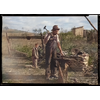
Let there be Color!: Joint End-to-end Learning of Global and Local Image
Priors for Automatic Image Colorization with Simultaneous Classification
Satoshi Iizuka*, Edgar Simo-Serra*, Hiroshi Ishikawa (* equal contribution)
ACM Transactions on Graphics (SIGGRAPH), 2016
We present a novel technique to automatically colorize grayscale images that
combines both global priors and local image features. Based on Convolutional Neural
Networks, our deep network features a fusion layer that allows us to elegantly
merge local information dependent on small image patches with global priors
computed using the entire image. The entire framework, including the global and
local priors as well as the colorization model, is trained in an end-to-end
fashion. Furthermore, our architecture can process images of any resolution, unlike
most existing approaches based on CNN. We leverage an existing large-scale scene
classification database to train our model, exploiting the class labels of the
dataset to more efficiently and discriminatively learn the global priors. We
validate our approach with a user study and compare against the state of the art,
where we show significant improvements. Furthermore, we demonstrate our method
extensively on many different types of images, including black-and-white
photography from over a hundred years ago, and show realistic colorizations.
@Article{IizukaSIGGRAPH2016,
author = {Satoshi Iizuka and Edgar Simo-Serra and Hiroshi Ishikawa},
title = {{Let there be Color!: Joint End-to-end Learning of Global and Local Image Priors for Automatic Image Colorization with Simultaneous Classification}},
journal = "ACM Transactions on Graphics (SIGGRAPH)",
year = 2016,
volume = 35,
number = 4,
}
We propose a novel approach for learning features from weakly-supervised data by
joint ranking and classification. In order to exploit data with weak labels, we
jointly train a feature extraction network with a ranking loss and a classification
network with a cross-entropy loss. We obtain high-quality compact discriminative
features with few parameters, learned on relatively small datasets without
additional annotations. This enables us to tackle tasks with specialized images not
very similar to the more generic ones in existing fully-supervised datasets. We
show that the resulting features in combination with a linear classifier surpass
the state-of-the-art on the Hipster Wars dataset despite using features only 0.3%
of the size. Our proposed features significantly outperform those obtained from
networks trained on ImageNet, despite being 32 times smaller (128 single-precision
floats), trained on noisy and weakly-labeled data, and using only 1.5% of the
number of parameters.
@InProceedings{SimoSerraCVPR2016,
author = {Edgar Simo-Serra and Hiroshi Ishikawa},
title = {{Fashion Style in 128 Floats: Joint Ranking and Classification using Weak Data for Feature Extraction}},
booktitle = "Proceedings of the Conference on Computer Vision and Pattern Recognition (CVPR)",
year = 2016,
}
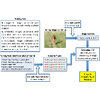
Structured Prediction with Output Embeddings for Semantic Image
Annotation
Ariadna Quattoni, Arnau Ramisa, Pranava Swaroop Madhyastha, Edgar Simo-Serra,
Francesc Moreno-Noguer
Conference of the North American Chapter of the Association for Computational
Linguistics: Human Language Technologies (NAACL-HLT, Short), 2016
We address the task of annotating images with semantic tuples. Solving this problem
requires an algorithm which is able to deal with hundreds of classes for each
argument of the tuple. In such contexts, data sparsity becomes a key challenge, as
there will be a large number of classes for which only a few examples are
available. We propose handling this by incorporating feature representations of
both the inputs (images) and outputs (argument classes) into a factorized
log-linear model, and exploiting the flexibility of scoring functions based on
bilinear forms. Experiments show that integrating feature representations of the
outputs in the structured prediction model leads to better overall predictions. We
also conclude that the best output representation is specific for each type of
argument.
@InProceedings{QuattoniARXIV2016,
author = {Ariadna Quattoni and Arnau Ramisa and Pranava Swaroop Madhyastha and Edgar Simo-Serra and Francesc Moreno-Noguer},
title = {{Structured Prediction with Output Embeddings for Semantic Image Annotation}},
booktitle = "Proocedings of Conference of the North American Chapter of the Association for Computational Linguistics: Human Language Technologies (NAACL-HLT)",
year = 2016,
}
地球観測衛星画像上の地物自動認識
中村 良介,石井 智大,野里 博和,坂無 英徳,シモセラ エドガー,望月 義彦,飯塚 里志,石川 博
人工知能学会全国大会, 2016
2015
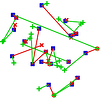
Discriminative Learning of Deep Convolutional Feature Point
Descriptors
Edgar Simo-Serra*, Eduard Trulls*, Luis Ferraz, Iasonas Kokkinos, Pascal Fua,
Francesc Moreno-Noguer (* equal contribution)
International Conference on Computer Vision (ICCV), 2015
Deep learning has revolutionalized image-level tasks, e.g. image classification,
but patch-level tasks, e.g. point correspondence still rely on hand-crafted
features, such as SIFT. In this paper we use Convolutional Neural Networks (CNNs)
to learn discriminant patch representations and in particular train a Siamese
network with pairs of (non-)corresponding patches. We deal with the large number of
non-corresponding patches with the combination of stochastic sampling of the
training set and an aggressive mining strategy biased towards patches that are hard
to classify. Our models are fully convolutional, efficient to compute and amenable
to modern GPUs, and can be used as a drop-in replacement for SIFT. We obtain
consistent performance gains over the state of the art, and most importantly
generalize well against scaling and rotation, perspective transformation, non-rigid
deformation, and illumination changes.
@InProceedings{SimoSerraICCV2015,
author = {Edgar Simo-Serra and Eduard Trulls and Luis Ferraz and Iasonas Kokkinos and Pascal Fua and Francesc Moreno-Noguer},
title = {{Discriminative Learning of Deep Convolutional Feature Point Descriptors}},
booktitle = "Proceedings of the International Conference on Computer Vision (ICCV)",
year = 2015,
}
In this paper, we analyze the fashion of clothing of a large social website. Our
goal is to learn and predict how fashionable a person looks on a photograph and
suggest subtle improvements the user could make to improve her/his appeal. We
propose a Conditional Random Field model that jointly reasons about several
fashionability factors such as the type of outfit and garments the user is wearing,
the type of the user, the photograph's setting (e.g., the scenery behind the user),
and the fashionability score. Importantly, our model is able to give rich feedback
back to the user, conveying which garments or even scenery she/he should change in
order to improve fashionability. We demonstrate that our joint approach
significantly outperforms a variety of intelligent baselines. We additionally
collected a novel heterogeneous dataset with 144,169 user posts containing diverse
image, textual and meta information which can be exploited for our task. We also
provide a detailed analysis of the data, showing different outfit trends and
fashionability scores across the globe and across a span of 6 years.
@InProceedings{SimoSerraCVPR2015,
author = {Edgar Simo-Serra and Sanja Fidler and Francesc Moreno-Noguer and Raquel Urtasun},
title = {{Neuroaesthetics in Fashion: Modeling the Perception of Fashionability}},
booktitle = "Proceedings of the Conference on Computer Vision and Pattern Recognition (CVPR)",
year = 2015,
}
We propose a robust and efficient method to estimate the pose of a camera with
respect to complex 3D textured models of the environment that can potentially
contain more than 100,000 points. To tackle this problem we follow a top down
approach where we combine high-level deep network classifiers with low level
geometric approaches to come up with a solution that is fast, robust and accurate.
Given an input image, we initially use a pre-trained deep network to compute a
rough estimation of the camera pose. This initial estimate constrains the number of
3D model points that can be seen from the camera viewpoint. We then establish
3D-to-2D correspondences between these potentially visible points of the model and
the 2D detected image features. Accurate pose estimation is finally obtained from
the 2D-to-3D correspondences using a novel PnP algorithm that rejects outliers
without the need to use a RANSAC strategy, and which is between 10 and 100 times
faster than other methods that use it. Two real experiments dealing with very large
and complex 3D models demonstrate the effectiveness of the approach.
@InProceedings{RubioICRA2015,
author = {Antonio Rubio and Michael Villamizar and Luis Ferraz and Adri\'an Pe\~nate-S\'anchez and Arnau Ramisa and Edgar Simo-Serra and Alberto Sanfeliu and Francesc Moreno-Noguer},
title = {{Efficient Monocular Pose Estimation for Complex 3D Models}},
booktitle = "Proceedings of the International Conference in Robotics and Automation (ICRA)",
year = 2015,
}
We propose a novel kinematic prior for 3D human pose tracking that allows
predicting the position in subsequent frames given the current position. We first
define a Riemannian manifold that models the pose and extend it with its Lie
algebra to also be able to represent the kinematics. We then learn a joint Gaussian
mixture model of both the human pose and the kinematics on this manifold. Finally
by conditioning the kinematics on the pose we are able to obtain a distribution of
poses for subsequent frames that which can be used as a reliable prior in 3D human
pose tracking. Our model scales well to large amounts of data and can be sampled at
over 100,000 samples/second. We show it outperforms the widely used Gaussian
diffusion model on the challenging Human3.6M dataset.
@InProceedings{SimoSerraMVA2015,
author = {Edgar Simo-Serra and Carme Torras and Francesc Moreno-Noguer},
title = {{Lie Algebra-Based Kinematic Prior for 3D Human Pose Tracking}},
booktitle = "International Conference on Machine Vision Applications (MVA)",
year = 2015,
}
Recent advances in 3D shape analysis and recognition have shown that heat diffusion
theory can be effectively used to describe local features of deforming and scaling
surfaces. In this paper, we show how this description can be used to characterize
2D image patches, and introduce DaLI, a novel feature point descriptor with high
resilience to non-rigid image transformations and illumination changes. In order to
build the descriptor, 2D image patches are initially treated as 3D surfaces.
Patches are then described in terms of a heat kernel signature, which captures both
local and global information, and shows a high degree of invariance to non-linear
image warps. In addition, by further applying a logarithmic sampling and a Fourier
transform, invariance to photometric changes is achieved. Finally, the descriptor
is compacted by mapping it onto a low dimensional subspace computed using Principal
Component Analysis, allowing for an efficient matching. A thorough experimental
validation demonstrates that DaLI is significantly more discriminative and robust
to illuminations changes and image transformations than state of the art
descriptors, even those specifically designed to describe non-rigid deformations.
@Article{SimoSerraIJCV2015,
author = {Edgar Simo-Serra and Carme Torras and Francesc Moreno Noguer},
title = {{DaLI: Deformation and Light Invariant Descriptor}},
journal = {International Journal of Computer Vision (IJCV)},
volume = {115},
number = {2},
pages = {136--154},
year = 2015,
}
2014
In this paper we tackle the problem of semantic segmentation of clothing. We frame
the problem as the one of inference in a pose-aware Markov random field which
exploits appearance, figure/ground segmentation, shape and location priors for each
garment as well as similarities between segments and symmetries between different
human body parts. We demonstrate the effectiveness of our approach in the
fashionista dataset and show that we can obtain a significant improvement over the
state-of-the-art.
@InProceedings{SimoSerraACCV2014,
author = {Edgar Simo-Serra and Sanja Fidler and Francesc Moreno-Noguer and Raquel Urtasun},
title = {{A High Performance CRF Model for Clothes Parsing}},
booktitle = "Proceedings of the Asian Conference on Computer Vision (ACCV)",
year = 2014,
}
We present a novel approach for learning a finite mixture model on a Riemannian
manifold in which Euclidean metrics are not applicable and one needs to resort to
geodesic distances consistent with the manifold geometry. For this purpose, we draw
inspiration on a variant of the expectation-maximization algorithm, that uses a
minimum message length criterion to automatically estimate the optimal number of
components from multivariate data lying on an Euclidean space. In order to use this
approach on Riemannian manifolds, we propose a formulation in which each component
is defined on a different tangent space, thus avoiding the problems associated with
the loss of accuracy produced when linearizing the manifold with a single tangent
space. Our approach can be applied to any type of manifold for which it is possible
to estimate its tangent space. In particular, we show results on synthetic examples
of a sphere and a quadric surface and on a large and complex dataset of human
poses, where the proposed model is used as a regression tool for hypothesizing the
geometry of occluded parts of the body.
@InProceedings{SimoSerraBMVC2014,
author = {Edgar Simo-Serra and Carme Torras and Francesc Moreno-Noguer},
title = {{Geodesic Finite Mixture Models}},
booktitle = "Proceedings of the British Machine Vision Conference (BMVC)",
year = 2014,
}
This paper presents a methodology for the description and finite-position
dimensional synthesis of articulated systems with multiple end-effectors. The
articulated system is represented as a rooted tree graph. Graph and dimensional
synthesis theories are applied to determine when exact finite-position synthesis
can be performed on the tree structures by considering the motion for all the
possible subgraphs. Several examples of tree topologies are presented and
synthesized. This theory has an immediate application on the design of novel
multi-fingered hands.
@Article{SimoSerraMAMT2014,
author = {Edgar Simo-Serra and Alba Perez-Gracia},
title = {{Kinematic Synthesis using Tree Topologies}},
journal = {Mechanism and Machine Theory},
volume = {72},
pages = {94--113},
year = 2014,
}
2013
We introduce a novel approach to automatically recover 3D human pose from a single
image. Most previous work follows a pipelined approach: initially, a set of 2D
features such as edges, joints or silhouettes are detected in the image, and then
these observations are used to infer the 3D pose. Solving these two problems
separately may lead to erroneous 3D poses when the feature detector has performed
poorly. In this paper, we address this issue by jointly solving both the 2D
detection and the 3D inference problems. For this purpose, we propose a Bayesian
framework that integrates a generative model based on latent variables and
discriminative 2D part detectors based on HOGs, and perform inference using
evolutionary algorithms. Real experimentation demonstrates competitive results, and
the ability of our methodology to provide accurate 2D and 3D pose estimations even
when the 2D detectors are inaccurate.
@InProceedings{SimoSerraCVPR2013,
author = {Edgar Simo-Serra and Ariadna Quattoni and Carme Torras and Francesc Moreno-Noguer},
title = {{A Joint Model for 2D and 3D Pose Estimation from a Single Image}},
booktitle = "Proceedings of the Conference on Computer Vision and Pattern Recognition (CVPR)",
year = 2013,
}
2012
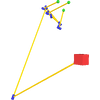
Kinematic Synthesis of Multi-Fingered Robotic Hands for Finite and
Infinitesimal Tasks
Edgar Simo-Serra, Alba Perez-Gracia, Hyosang Moon, Nina Robson
Advances in Robot Kinematics (ARK), 2012
In this paper we present a novel method of designing multi-fingered robotic hands
using tasks composed of both finite and infinitesimal motion. The method is based
on representing the robotic hands as a kinematic chain with a tree topology. We
represent finite motion using Clifford algebra and infinitesimal motion using Lie
algebra to perform finite dimensional kinematic synthesis of the multi-fingered
mechanism. This allows tasks to be defined not only by displacements, but also by
the velocity and acceleration at different positions for the design of robotic
hands. An example task is provided using an experimental motion capture system and
we present the design of a robotic hand for the task using a hybrid Genetic
Algorithm/Levenberg-Marquadt solver.
@InProceedings{SimoSerraARK2012,
author = {Edgar Simo-Serra and Alba Perez-Gracia and Hyosang Moon and Nina Robson},
title = {{Kinematic Synthesis of Multi-Fingered Robotic Hands for Finite and Infinitesimal Tasks}},
booktitle = "Advances in Robot Kinematics (ARK)",
year = 2012,
}
Markerless 3D human pose detection from a single image is a severely
underconstrained problem in which different 3D poses can have very similar image
projections. In order to handle this ambiguity, current approaches rely on prior
shape models whose parameters are estimated by minimizing image-based objective
functions that require 2D features to be accurately detected in the input images.
Unfortunately, although current 2D part detectors algorithms have shown promising
results, their accuracy is not yet sufficiently high to subsequently infer the 3D
human pose in a robust and unambiguous manner. We introduce a novel approach for
estimating 3D human pose even when observations are noisy. We propose a stochastic
sampling strategy to propagate the noise from the image plane to the shape space.
This provides a set of ambiguous 3D shapes, which are virtually undistinguishable
using image-based information alone. Disambiguation is then achieved by imposing
kinematic constraints that guarantee the resulting pose resembles a 3D human shape.
We validate our approach on a variety of situations in which state-of-the-art 2D
detectors yield either inaccurate estimations or partly miss some of the body
parts.
@InProceedings{SimoSerraCVPR2012,
author = {Edgar Simo-Serra and Arnau Ramisa and Guillem Aleny\`a and Carme Torras and Francesc Moreno-Noguer},
title = {{Single Image 3D Human Pose Estimation from Noisy Observations}},
booktitle = "Proceedings of the Conference on Computer Vision and Pattern Recognition (CVPR)",
year = 2012,
}
2011

Design of Non-Anthropomorphic Robotic Hands for Anthropomorphic
Tasks
Edgar Simo-Serra, Francesc Moreno-Noguer, Alba Perez-Gracia
ASME International Design Engineering Technical Conferences (IDETC),
2011
In this paper, we explore the idea of designing non-anthropomorphic, multi-fingered
robotic hands for tasks that replicate the motion of the human hand. Taking as
input data rigid-body trajectories for the five fingertips, we develop a method to
perform dimensional synthesis for a kinematic chain with a tree structure, with
three common joints and five branches. We state the forward kinematics equations of
relative displacements for each serial chain expressed as dual quaternions, and
solve for up to five chains simultaneously to reach a number of poses along the
hand trajectory using a hybrid global numerical solver that integrates a genetic
algorithm and a Levenberg-Marquardt local optimizer. Although the number of
candidate solutions in this problem is very high, the use of the genetic algorithm
lets us to perform an exhaustive exploration of the solution space and retain a
subset of them. We then can choose some of the solutions based on the specific task
to perform. Note that these designs could match the task exactly while having a
finger design radically different from that of the human hand.
@InProceedings{SimoSerraIDETC2011,
author = {Edgar Simo-Serra and Francesc Moreno-Noguer and Alba Perez-Gracia},
title = {{Design of Non-Anthropomorphic Robotic Hands for Anthropomorphic Tasks}},
booktitle = "Proceedings of the 2011 ASME International Design Engineering Technical Conferences",
year = 2011,
}
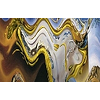
Deformation and Illumination Invariant Feature Point Descriptor
Francesc Moreno-Noguer
Conference in Computer Vision and Pattern Recognition (CVPR), 2011
Recent advances in 3D shape recognition have shown that kernels based on diffusion
geometry can be effectively used to describe local features of deforming surfaces.
In this paper, we introduce a new framework that allows using these kernels on 2D
local patches, yielding a novel feature point descriptor that is both invariant to
non-rigid image deformations and illumination changes. In order to build the
descriptor, 2D image patches are embedded as 3D surfaces, by multiplying the
intensity level by an arbitrarily large and constant weight that favors anisotropic
diffusion and retains the gradient magnitude information. Patches are then
described in terms of a heat kernel signature, which is made invariant to intensity
changes, rotation and scaling. The resulting feature point descriptor is proven to
be significantly more discriminative than state of the art ones, even those which
are specifically designed for describing non-rigid image deformations.
@InProceedings{MorenoNoguerCVPR2011,
author = {Francesc Moreno-Noguer},
title = {{Deformation and Illumination Invariant Feature Point Descriptor}},
booktitle = "Proceedings of the Conference on Computer Vision and Pattern Recognition (CVPR)",
year = 2011,
}
